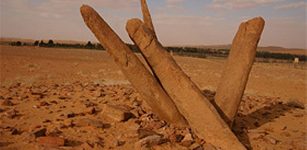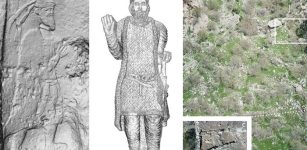Chaco Canyon Mystery Solved By Scientists Hauling Logs On Their Heads
Jan Bartek - AncientPages.com - In a new study, several researchers at the University of Colorado Boulder reenacted a small part of a trek that people in the Southwest United States may have made more than 1,000 years ago.
Rodger Kram, associate professor emeritus of integrative physiology, and James Wilson, then an undergraduate studying biochemistry, spent the summer of 2020 training for an impressive test of endurance: Together, they carried a ponderosa pine log weighing more than 130 pounds for 15 miles up and down a forest road in Boulder County, Colorado—and they did it using only their heads in a technique inspired, in part, by sherpas in Nepal.
James Wilson, left, and Rodger Kram, right, carry a ponderosa pine log weighing more than 130 pounds in Chautauqua Park in Boulder, Colorado. Credit: Patrick Campbell/CU Boulder
"Some people baked sourdough bread during COVID, Instead, we carried sand and heavy logs around using our heads," said Kram, who is a passionate runner in his free time.
He and Wilson weren't trying to start a new exercise fad. Instead, they were hoping to solve an archaeological mystery that has perplexed researchers for decades: How did ancient peoples transport more than 200,000 heavy construction timbers over 60 miles to a famous site in the Southwest called Chaco Canyon?
The duo and their colleagues described their experiment Feb. 22 in the Journal of Archaeological Science: Reports.
The team's findings show that the key to this testament to human labor may have been simple devices called tumplines. These straps, which sherpas, or native mountain peoples of Nepal, still widely use today, loop over the top of the head. They help porters to support weight using the bones of their neck and spine rather than their muscles. Archaeological evidence suggests that ancient peoples in the Southwest employed tumplines woven from yucca plants to transport everyday items like food and water.
"Tumplines allow one to carry heavier weights over larger distances without getting fatigued," said Wilson, now a medical student at the CU Anschutz Medical Campus.
Chaco Canyon sits near the border between New Mexico and Colorado. Thousands of people, the ancestors of today's Diné, or Navajo, and Pueblo peoples, may have lived there from around A.D. 850 to 1200. They built "Great Houses," which were as much as four stories tall and contained hundreds of rooms.
But how this society got its construction supplies has been a long-standing mystery. Human porters would have needed to carry 16-foot-long wooden beams to Chaco Canyon by foot—following a network of ancient roads to sites like the Chuska Mountains to the west.
The team's findings open up a new understanding of the day-to-day lives of the people who shaped the Southwest more than a thousand years ago, said study co-author Robert Weiner.
"The mountains are the most sacred places for the descendant Diné and Pueblo peoples. I've heard people say, 'That's our church. That's where we go to heal, to pray,'" said Weiner, who will receive his doctorate in anthropology from CU Boulder later this spring. "These timbers brought pieces of the sacred mountains to Chaco Canyon."
A new measurement
Kram got interested in Chaco Canyon several years ago.
He read a statistic suggesting that the mass of a typical roof beam, or "viga," in a Chacoan Great House likely averaged around 275 kilograms (more than 600 pounds). The number, Kram discovered, could be traced back to a study published in the 1980s. It seemed unrealistically high to him.
James Wilson and Rodger Kram carry a log with tumplines with the Boulder Foothills in the background. Credit: Patrick Campbell/CU Boulder
"I cut a 1-foot-long section of pine and weighed it on my bathroom scale," said Kram, who lives on a wooded property in the hills west of Boulder. "I multiplied by 16 feet and realized, 'That can't add up to 275 kilograms.'"
He and Wilson decided to read everything they could about the properties of dried wood. In a 2022 study, they and their colleagues estimated that a pine log measuring about 16 feet long probably weighed closer to 85 kilograms (a little over 185 pounds).
"Once we corrected the mass of the timbers," Wilson said, "that changed almost everything about how many people were required to carry those timbers, how much time it would take to cover 60 miles."
Put the weight on me
The duo wanted to find out if such a journey would be possible. They first tried carrying a log on their shoulders.
"It was just debilitating," Kram said. "It's just a dumb way to carry a heavy object."
Then the researchers hit on the idea of tumplines, which are depicted in ceramic effigies recovered from close to Chaco Canyon.
To make sure they were being safe, Kram and Wilson started with light loads and worked their way up, said Joseph Carzoli, a study co-author and certified strength and conditioning coach.
"I had Dr. Kram and James initially focus on walking greater and greater distances with what felt like light tumpline training loads," said Carzoli, who earned his doctorate in integrative physiology from CU Boulder in 2022. "As they became more comfortable with their training, we began alternating training days between carrying light loads for greater distances and heavier loads for shorter distances."
See also: More Archaeology News
The most uncomfortable part, Wilson noted, was the strap of the tumpline rubbing into his head.
The irritation paid off. Weiner said the team's results show that supplying Chaco Canyon with goods may not have been as back-breaking an undertaking as archaeologists once assumed.
"As these guys showed, you don't have to be super trained to carry a log," he said.
The study was published in Journal of Archaeological Science: Reports
Written by Jan Bartek – AncientPages.com Staff Writer






















